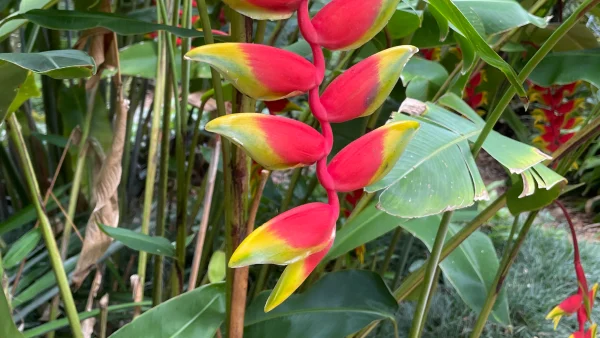
Eureka Springs Conservation Park features a greenhouse, boardwalk, tropical gardens, and an unexpected founding
Tucked away in central Hillsborough County, bordering the Tampa Executive Airport, is an enchanting tropical oasis. Eureka Springs Conservation Park is one of a kind -- lush with ferns, brimming with orchids, and shaded by scores of massive oak trees. Running through the 31 acres -- sometimes seen, but often hidden -- are 11 natural springs keeping these hardwood cypress swamp lands fertile and flourishing.
How did this rainforest-like sanctuary come to be? A surprising origin story tells how an accomplished horticulturist and fish-farming pioneer built a lasting botanical legacy for all to delight in.

From Russia to Tampa
The man behind the gardens and former fish farm is as interesting as the park itself. Fitting to his aquatic pursuits, Albert Greenberg was born aboard a British ship in 1896 in the Black Sea. He was registered as a U.S. citizen at the American Consulate in Odessa, Ukraine (at the time, part of Russia) and raised in Chicago.
Greenberg attended public school in Chicago and later enrolled in the University of Illinois. After the First World War broke out, he withdrew from his studies to enlist in the Navy. Following his military service, he made a living as a traveling salesman for a chemical company, eventually working his way through the Southeast.
Greenberg settled in Hillsborough County in the early 1930s and purchased 80 acres of swamp lands running along Six Mile Creek. At the time, 11 free-flowing springs kept the area lush and verdant, perfect for establishing his tropical fish farm, Everglades Aquatic Nurseries. Greenberg named his then jungle-like property Eureka Springs.
At first by hand and later with the help of a donkey, Greenberg dug spring-fed canals to keep his gardens watered and fishponds full. By engineering a spring-based irrigation system and manipulating water flow across his property, the aquatic pioneer created the perfect environment for cultivating fish and aquarium plants.
When he wasn't creating new hybrid plant species, Greenberg traveled extensively. He collected many of his plant specimens, personally, from Africa, Central and South America, and the Caribbean. Some of the exotic plants displayed in the park today belonged and were tended to by Greenberg himself.
Greenberg's business thrived as he developed innovative ways to ship his aquaculture products and crossbred plant varieties. One such plant was the "Albert Greenberg" tropical water lily (Nymphaea 'Albert Greenberg'), which is admired for its vibrant yellow center surrounded by soft pink pedals.

Greenberg's living legacy
Though Greenberg did not marry or have children, he had an extended chosen family. Over the years, many botanists and biologists were drawn to his gardens and fish nursery, often intrigued by Greenburg's hybridized plant creations and modern fish farming techniques. To accommodate his frequent guests, the welcoming gardener built several shanties throughout the forest to house visitors (none of which remain, today). Greenburg was also very close with the staff that worked in his nursery. Five of his employees, some who worked with him for over 25 years, were included in his will.
Greenberg is widely respected for his advancements in both fish farming and botany. In fact, he was the first to be inducted to the Florida Tropical Fish Farms Association Hall of Fame in 1990. In 2007, he was honored with admittance into the Florida Agricultural Hall of Fame.
In 1993 Greenberg died at the age of 96. His cremated remains and a memorial dedicated to him are in Eureka Springs Conservation Park. The generous botanist donated Eureka Springs to Hillsborough County in 1967 with the stipulation that it remain open to the public. Today, it is the only botanical garden in the county park system.
Get lost in a tropical retreat
Though Eureka Springs has changed since the days when Greenberg lovingly tended his cryptocorynes (a popular type of aquarium plant), the park continues to lure horticulturists, nature enthusiasts, and photographers.
If you go, be sure to slow down so you can see and smell all that is around you. Visitors will notice different scents throughout the gardens, as well as a wide variety of both exotic and native plant species along the paths and boardwalk. Guests should also keep an eye out for the extensive flora growing on the trees in the vast canopy above.
What to see in Eureka Springs Conservation Park:
- Take time to leisurely stroll along the shaded, .3-mile-long boardwalk. The path takes amblers through a floodplain forest of maples, cypresses, and black gum. If enough water is flowing, you may catch a glimpse of one of the larger springs, Angel Spring, bubbling along the boardwalk.
- The greenhouse should not be missed! Orchids, vandas, various hanging arrangements, and plants collected and tended by Greenberg himself are on display. Inside you will notice the ground paved with repurposed bricks. These, at one time, lined the streets of Ybor.
- Outside the greenhouse entrance is an ornamental pond, lush with aquatic plants and home to brightly colored koi fish.
- The picturesque pergola is a lovely spot for special occasion photos or everyday selfies.
- Throughout the gardens are giant oak trees, some hundreds of years old. These solid, old beauties are covered in mosses, ferns, and bromeliads.
- With luck, you may catch the lobster claw plants (Heliconia rostrata) blooming. The vibrant red bracts on these plants resemble their namesake and grow in hanging, eye-catching clusters.
- If needed, indoor restrooms can be found by the enclosed pavilion. The pavilion is air-conditioned and available for rent.
Bonus: Though they're technically not part of Eureka Springs Conservation Park, you may encounter peacocks. These colorful birds live in the neighborhood and are often spotted strutting around the park entrance.
Eureka Springs Conservation Park is at 6400 Eureka Springs Rd., Tampa, FL 33610. The park is open 7 days a week, 8 a.m. to 6 p.m. The park entrance fee is $2.

